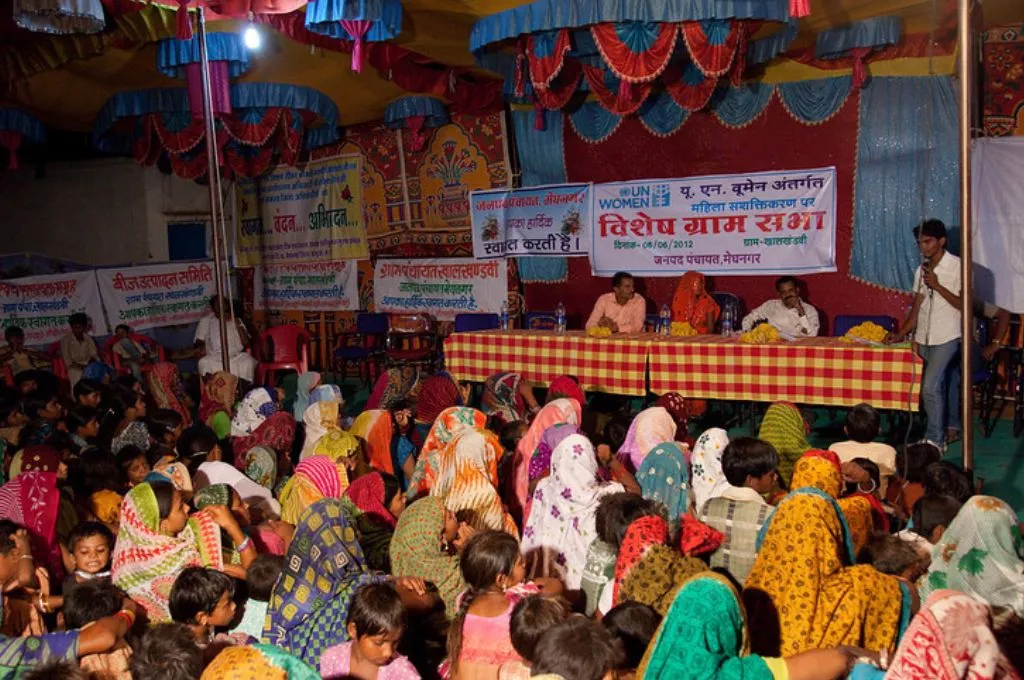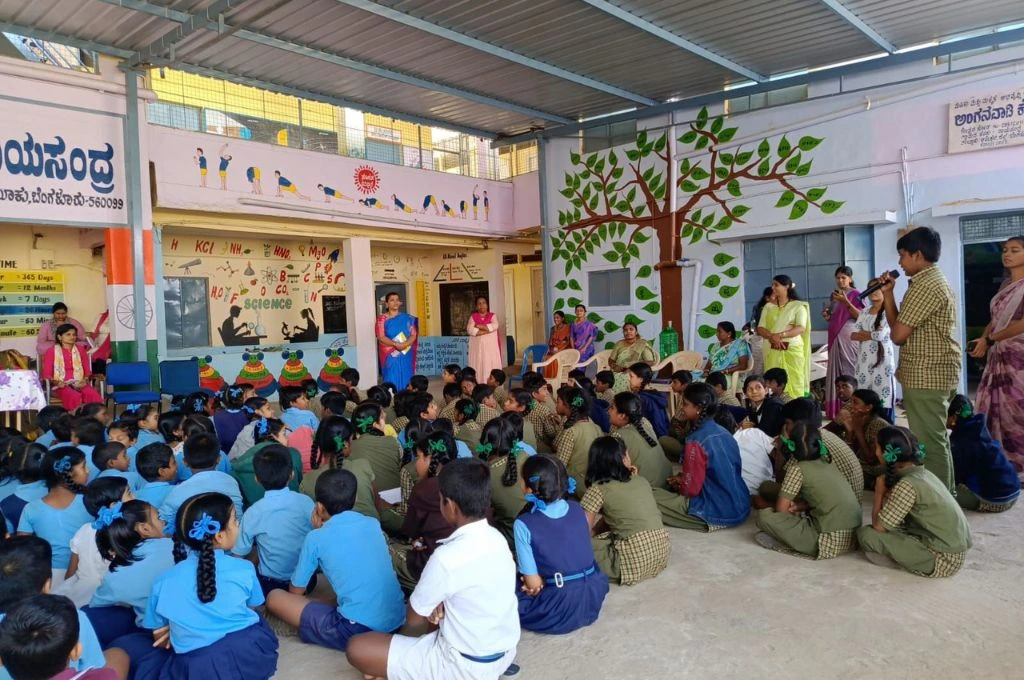Panchayats are a form of local self-government in rural India, and were institutionalised by the 73rd Constitutional Amendment Act of 1993. They act as the third tier of the government and derive their power from the state governments. The Union Government provides assistance to the states to strengthen village panchayats and decentralise power to the grassroots level for effective local public service delivery.
The Ministry of Panchayati Raj released a report titled Status of Devolution to Panchayats in States—An Indicative Evidence Based Ranking, also referred to as Panchayat Devolution Index 2024. It assesses the enabling environment created by the states for panchayats to function as institutions of self-government across various indicators.

The study had the following objectives:
- To assess how well the states are implementing decentralisation. This includes the transfer of functions, institutions, functionaries, and finances to Panchayati Raj Institutions in the 29 subjects listed in the 11th Schedule such as agriculture, rural infrastructure, and education.
- To examine the role of the panchayats in managing committees and institutions.
- To assess their role in implementation of centrally sponsored schemes such as MGNREGA, SSA, NHM, and PMAY.
- To create a ranking of states and union territories (UTs) based on how well they are devolving or transferring powers and resources to panchayats.
The data for the study was collected through a questionnaire sent to all states as well as from the field to supplement or validate the data received from state governments.
The study covered all states and union territories, except:
- Meghalaya, Mizoram, and Nagaland, where Part IX of the Constitution doesn’t apply as these are tribal areas (Article 243M).
- Delhi, where panchayats were abolished in 1990, and Chandigarh, where no panchayats exist.
- Arunachal Pradesh and Manipur, due to riots and unrest in Manipur.
- Lakshadweep, Dadra and Nagar Haveli, and Daman and Diu, where updated data was not provided.
The study evaluated each state across six dimensions and combined the scores across all dimensions to arrive at the devolution index and statewise ranking.
In addition to the performance assessment, the report also outlines recommendations to improve the score. Here’s what each dimension means, as well as the states’ performance across them and the report’s recommendations.
1. Framework
The framework dimension evaluates the legal requirements that state governments must meet for panchayats. This includes holding regular panchayat elections; reserving seats for women, Scheduled Castes (SCs), and Scheduled Tribes (STs); and establishing the State Election Commission (SEC), State Finance Commission (SFC), and District Planning Committees (DPCs). States that do not fulfil these criteria were kept outside the purview of the study.
Overall, Kerala ranks first with a score of 83.56, followed by Maharashtra (74.74), Karnataka (74.43), and Haryana (73.3). Uttarakhand, Tripura, Sikkim, and Himachal Pradesh are among the states that have scored above the national average of 54.3. Andaman and Nicobar Islands is the only UT above the national average.
Some recommendations for improving this dimension are:
- All states should keep reserved seats for women, SCs, and STs. In fact, most states have increased their reservation quota from one-third to half of the total number of seats. However, tenure on reserved seats should be increased from the same constituency for candidates to perform more efficiently.
- As a mandate, panchayats and municipalities are meant to create a draft development plan for the entire district. This plan—to be consolidated by the DPC—is then sent to the state government to be integrated into the state plan. It provides a comprehensive picture of the district’s developmental needs and opportunities, and thus helps in allocating resources more effectively. However, the report found that although DPCs have been constituted in almost all states, such detailed grassroots planning is undertaken in very few places. Kerala and Rajasthan have the highest score in the establishment and functioning of DPCs, followed by Sikkim. Given the importance of aligning policies at the state and the national level, an institutional framework needs to be established to ensure a regular district plan is formalised by all the states.
2. Functions
This dimension evaluates the functions devolved by the state to panchayats, and the role of the panchayats in implementing schemes of social justice and economic development designed by the central and state governments. Overall, Tamil Nadu tops the list with an index value of 60.24, followed by Karnataka (57.62), Odisha (57.46), and Rajasthan (56.13).
Sikkim with a score of 42.59 is the only state among the northeastern and hilly states—a group comprising all the states in the Northeast as well as Himachal Pradesh and Uttarakhand—that has scored above the national average of 29.18. None of the UTs are above the national average. Even though this dimension forms the base of local self-governance, it has the lowest national average among all the dimensions.
Disaggregating the data, here’s what the report found:
- Based on how actively the panchayats are involved in roles such as the identification of various schemes’ target populations and scheme implementation, the top-ranked states are Tamil Nadu, Rajasthan, and Odisha. According to Article 243G, the panchayats are central in implementing Central Sector Schemes (CSSs) on subjects in the 11th Schedule. Hence, CSSs need to be improved in integrating the role of panchayats.
- The study found that a few parastatal bodies—those partially or fully owned by the state—operate in areas earmarked for panchayats in the 11th Schedule, depriving the panchayat of its rightful mandates. Therefore, the study recommends that all funds of the union and state governments should be transferred to the panchayats, and not to parallel bodies, for effective functioning. To improve accountability, each scheme should contain guidelines for electronic tracking of CSS funds to the panchayats through the states.
- At the gram panchayat (GP) level, various government departments run their own development programmes. However, these efforts often happen in silos, leading to duplication and a lack of coordination. The Gram Panchayat Development Plan (GPDP) is built to address this by acting as a comprehensive, unified document that captures the full picture of the panchayat’s needs and priorities. Ideally, plans and budgets from different line departments—including those for labour—should be shaped by the GPDP, even if the actual implementation remains with those departments. This integrated planning not only improves service delivery but also helps attract funding from multiple sectors and strengthens the use of local resources.
3. Finances
This dimension is built on several indicators, such as:
- timely release of the 15th Finance Commission grants to panchayats
- regular and effective functioning of the SFC
- SFC transfer to panchayats
- power to collect revenue
- funds available with panchayats
- expenditure by panchayats as percentage of state’s public expenditure
- accounts and budget
Nineteen states are above the national average and Karnataka leads in this sub-index with a score of 70.65, followed by Kerala (62.89), Tamil Nadu (55.78), and Rajasthan (54.56).
For the panchayats to effectively utilise its funds, the state government should ensure timely release of funds without any ambiguous conditions placed on fiscal transfers. If states retain the unspent funds, it erodes the foundation of decentralised democracy and takes away from the panchayat’s decision-making power.
When statutory transfers to panchayats/municipalities (like those recommended by finance commissions) are made after states receive money, it makes local governments financially dependent on the states and often leaves them underfunded. To solve for this, the Consolidated Fund of India, through which states receive funds and transfer to panchayats, should be amended to include panchayats and municipalities in its purview.
4. Functionaries
The key indicators analysed in this dimension are:
- physical infrastructure of panchayats
- their e-connectivity
- panchayat officials
- sanctioned and actual staff
Gujarat ranks the highest here with a score of 90.94. Tamil Nadu is second with a score of 84.25, followed by Kerala with an index score of 82.99.
Here are some aspects of the indicators, along with relevant suggestions:
- Physical infrastructure is crucial for the administrative efficiency of panchayats. A proper office building, computers, and modern communication facilities are required for panchayats to conduct executive and other tasks efficiently. Gujarat and West Bengal are ahead in this, followed by Karnataka, Kerala, and Uttar Pradesh where there has been significant advancement in creating physical infrastructure and internet connectivity. But, the states of Arunachal Pradesh, Manipur, Odisha, Punjab, and the union territory of Ladakh need to focus on developing the infrastructure for better functioning of panchayats.
- Panchayats must also keep pace with technology. Smooth functioning requires digitisation in business processes such as having wireless connectivity and an e-mail address; using information and communication technology (ICT) for service delivery and uploading financial data; having a number of trained officials; and receiving ongoing support for computerisation, adoption of software applications, and development of software.
5. Capacity enhancement
This dimension is integral in assessing the steps taken by the states to strengthen panchayats and enable them to act as institutions of self-government. Key indicators of this dimension are: a) training institutions, and b) training activities of elected representatives and officials. Telangana secures the first rank with a score of 86.19, closely followed by Tamil Nadu, and Gujarat, with a score of 84.29 and 83.96 respectively. Seventeen states and two UTs (Jammu and Kashmir and Andaman and Nicobar Islands) scored more than the national average of 54.63.
The training of panchayat members is crucial in building their capacity and plays a pivotal role in the overall effectiveness of panchayats. Institutes at both the state and panchayat levels for training elected representatives and officials are crucial. Many factors including lack of education and inadequate finance inhibit the functioning of panchayat members and officials.
To improve state-level performance along this dimension, investment in training infrastructure needs to be enhanced. This includes the provision of adequate resources such as qualified trainers, computers, satellite communication facilities at training centres, residential training facilities, participatory and specialised approaches, and customised training material to cater to the specific learning requirements of panchayat members and officials, such as providing materials in local languages and in formats accessible to all.
6. Accountability
Accountability is an important dimension to ensure panchayats are answerable to the people and working in a fair and efficient manner. This dimension is built on various indicators:
- social audit
- functioning of the gram sabha
- transparency and anti-corruption
Karnataka has topped here with a score of 81.33, closely followed by Kerala, Maharashtra, and Uttar Pradesh with a score of 81.18, 80.36, and 76.07 respectively.
Here are the recommendations made by the report:
- To enhance accountability, panchayats should maintain essential records such as digital data, asset register, demand and collection register, and grant register. They should implement accountability mechanisms such as performance evaluations to ensure that members fulfil their responsibilities effectively. The Union Government must encourage the state governments, through an incentive or reward structure, to establish accountability mechanisms in all rungs of the panchayat.
- Social audits should be conducted on a regular basis to make the panchayat accountable not only to the state but also to residents. Schemes including MGNREGA, PMAY, SSA, ICDS, and AAY have provisions for social audits and its operation by gram sabha and others for better implementation.
If panchayats are to fulfil their constitutional promise, states must go beyond token devolution and take concrete steps to strengthen all six dimensions assessed in the index. This requires sustained political will, robust institutional frameworks, and active community participation at every level of governance.
—



